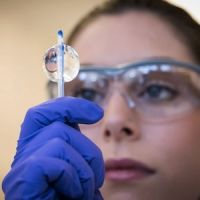On 21 February 2013, WHO issued its recommendation for the composition of influenza vaccines for the 2013-2014 influenza season in the northern hemisphere. A short headline report on the vaccine recommendations for next season is available as well as a more detailed report which also contains information on the antiviral resistance and the laboratory-assessed match between this season’s vaccine and circulating viruses.
The recommendations are that for trivalent vaccines for use in the 2013-14 influenza season (Northern Hemisphere winter) contain the following:
- For A(H1N1) an A/California/7/2009 (H1N1)pdm09-like virus; the same as during the current 2012-13 season;
- For A(H3N2) an A(H3N2) virus antigenically like the cell-propagated prototype virus A/Victoria/361/2011+;
- For B/Yagamata a B/Massachusetts/2/2012-like virus for the B/Yagamata lineage a change from the . B/Wisconsin/1/2010-like virus in 2012-2013.
- It is recommended that any quadrivalent vaccines containing two influenza B viruses also contain a B/Brisbane/60/2008-like virus for the B/Victoria lineage.
Producing these recommendations in its biannual influenza vaccine strain selection meetings is an important function of the laboratory aspect of the Global Influenza Surveillance and Response System (GISRS) coordinated by WHO. These scientific meetings take place around February and September each year and make respectively make recommendations on the antigens to be used in the influenza vaccines for the coming Northern Hemisphere (February meetings) and Southern Hemisphere seasons (September meetings).
The objectives of these meetings are to:
- Analyse the antigenic and genetic characteristics of influenza viruses circulating and infecting humans, taking into consideration of available epidemiological and clinical information from individual countries and regions;
- Make recommendations on the composition of the influenza vaccines for use in the northern and southern hemisphere - in this case for the 2013-2014 northern hemisphere season;
- Review the antigenic and genetic characteristics of recent A(H5N1) viruses that the WHO Collaborating Centres of the GISRS received and the need to develop new A(H5N1) candidate vaccine viruses for pandemic preparedness purposes;
- Review the antigenic and genetic characteristics of other subtype or variant influenza viruses, if any, infecting humans recently, and the need to develop new candidate vaccine viruses for pandemic preparedness purposes.
The meeting represents the end point of an intense period of work for National Influenza Centres who contribute viruses and detailed virological data to WHO’s six global influenza Collaborating Centres and four Essential Regulatory Laboratories who undertake more complex antigenic and genetic analyses. Scientists from centres and laboratories look carefully at the data from all across the world with the prime purpose of seeing how well the influenza viruses that have been circulating match the currently used vaccine antigen strains. This is with a view to whether there are other strains more suitable for vaccine production as they match the circulating viruses more closely when they are in use in vaccines. These discussions are undertaken privately. After a conclusion has been taken, the information is communicated to industry, regulators and other interested parties at an open session in Geneva. These recommendations are then taken for further formal decisions by regulators and industry with the decisions for Europe being overseen by the European Medicines Agency and the European Commission.
For more information, please visit: www.ecdc.europa.eu
Latest Articles
Infections
On 21 February 2013, WHO issued its recommendation for the composition of influenza vaccines for the 2013-2014 influenza season in the northern hemisphere....



























